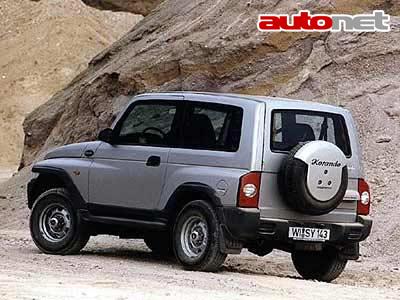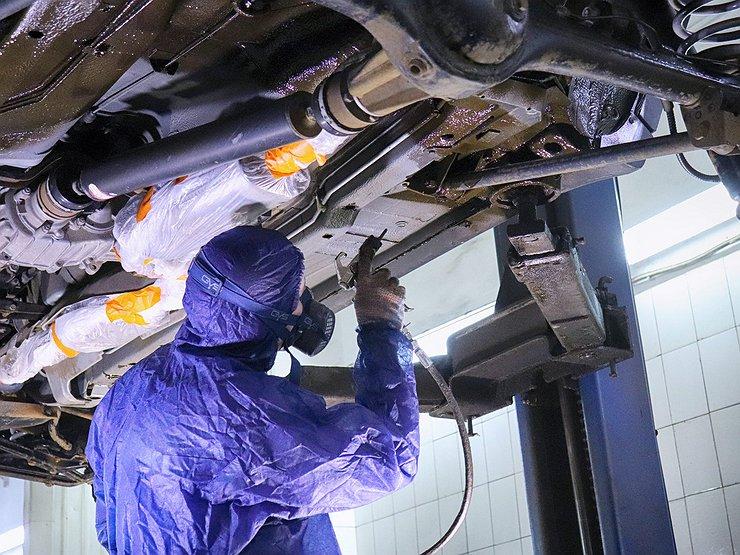
Daewoo Corando 2.3 TD
The transformation was imperceptible for many. Imperceptibly. Even today, many people talk about Ssangyong. Not surprising. Daewooers simply replaced the badges on the body and installed a slightly different mask in front of the refrigerator. There is even the logo of the previous brand on the steering wheel, as well as the inscription Ssangyong on the radio.
But otherwise everything is the same.
Wrong? Why? Koranda KJ, as he was once called, doesn't miss much. Its exterior is actually one of the few, if not the only one, that in the off-road segment, with its originality, suggests new directions. All the rest are very similar to each other - either square, or more or less faithful copies of the legendary jeep. Korando has a unique and, above all, recognizable appearance. It is a beautiful appearance that optically reduces it, as it is about four and a half meters long and well over a meter and three-quarters wide. It's not as much as a Hummer, but it's not a Seicento either.
Actually - but not to scare you - turning the steering wheel is quite a difficult job. Luckily, the Korand's body is well-glazed in terms of transparency, and the steering gear is assisted by power steering. As such, the only major gripe when it comes to the agility of this SUV is its rather large driving range. However, it will not be so noticeable even in the city, maybe more in the field, among the trees, when it will be necessary to turn in front of a tree that has fallen from the cart track.
I don't know what our design expert Gedle would say, but there are quite a few cleverly used ideas for Koranda's looks. The front fenders are also convex, and between them (along the entire length of the car) a long hood, which, together with the body in this part, tapers along a curve, so that the headlights are completely together.
There's also the obligatory off-road step between the protruding fenders, and the rest of the body is the least expressive, albeit important for being in the car.
Much less design ideas Korando showcases in the cabin, which is simple enough that it does not even bother especially SUVs (in general, this price range). They are more worried about cheap materials from the lower end of the quality scale, which is especially true for the plastic used. Even when it comes to ergonomics or handling comfort, the Korando doesn't fit.
He taught Daewoo nothing new.
The steering wheel can be lowered nicely, but then it almost completely covers the instruments, the levers on the steering wheel are uncomfortable, the buttons are illogically scattered across the dashboard, and the steering wheel is too close to the driver depending on the position of the pedals.
However, of all the above and not listed, the hellishly stiff gear shifter is the most annoying when driving. Sometimes, especially with cold oil in the transmission, it is necessary to engage rather roughly with it, but when the oil heats up to operating temperature, only fifth gear (when shifting up) and second gear (when shifting down). ) it is difficult to remain.
The fact that the gear lever has an idle speed of about 20 centimeters (and in a circle) is almost imperceptible when shifting.
The diesel-powered Korando is generally unfriendly cold. The heating of the combustion chamber is intelligent (a little shorter when the engine is warm), but always too long, and on cold winter days (especially if you are in a hurry to work) it borders on eternity. But the engine starts and runs flawlessly. Compared to the similar Korand, also called Ssangyong and equipped with a diesel engine (AM 97/14), this time it was equipped with a turbodiesel engine.
Not shockingly powerful, but much better than a conventional naturally aspirated diesel. Driving performance measured on the road became bearable with the added turbocharger. Now you can drive decently fast on the highway and sometimes even overtake. The new (actually different) engine also offers a significant improvement in field usability as it no longer needs to be rotated towards the red field as there is enough torque for around 2000 rpm.
The significant change that has taken place in Korandi since our last test is the ride. It's still detachable all-wheel drive, but you'll be looking for the power lever next to the gear lever in vain, as we're used to. Now the power is on (like from the beginning with Muss) and the small rotary knob for this task is to the right of the steering wheel on the dashboard (it's good to be careful as there is a completely similar knob on the left of the steering wheel, except that it serves to turn on the rear wiper !). The shifting itself is reliable, but the classic mechanical method - and not only with Korandi - is still better and 100% reliable. You know that each such system has its "flies".
Despite all the grievances, the Korando is a pretty enjoyable partner on and off the road. It has another flaw, but luckily it's easy to fix. The downside is rubber, which is from the M + S class, but on snow, mud and off-road conditions as a whole showed noticeably little. In fact, even on asphalt (especially on wet) they did not shine very much, but there the requirements are completely different and their properties are acceptably good.
But, nevertheless, Korando is an interesting SUV. It's possible that you won't go unnoticed, the ride won't turn your hair gray, and it still has a fair amount of good ride quality and equipment. In a way, above all with his appearance, of course, he could even be a role model for many.
What the Korean Daewoo will bring in the near future after the acquisition of the Ssangyong brand and the subsequent acquisition of the off-road vehicle program is still a mystery, but from the point of view of a potential buyer, the situation has not changed significantly. The same car will need to be obtained only in other car dealerships.
Few people really need an SUV. Most people buy such cars for the sake of their image, for joy and pleasure. Whether it's just driving an off-road vehicle or driving it here and there (optional) off-road. Let's say snow.
Vinko Kernc
Photo: Urosh Potocnik.
Daewoo Corando 2.3 TD
Basic data
| Sales: | Opel Southeast Europe Ltd. |
|---|---|
| Base model price: | 16.896,18 € |
| Test model cost: | 16.896,18 € |
| Power: | 74kW (101 KM) |
| Maximum speed: | 140 km / h |
| Mixed flow ECE: | 8,2l / 100km |
| Guarantee: | 3 years or 100.000 kilometers, 6 years rust proof, 1 year mobile warranty |
Costs (per year)
Technical information
| engine: | 4-cylinder - 4-stroke - in-line, front-chamber diesel - longitudinally mounted in front - bore and stroke 89,0 × 92,4 mm - displacement 2299 cm22,1 - compression 1:74 - maximum power 101 kW (4000 hp) at 12,3 / min - average piston speed at maximum power 32,2 m / s - specific power 43,9 kW / l (219 hp / l) - maximum torque 2000 Nm at 5 rpm - crankshaft in 1 bearings - 2 camshafts in the head (chain) - 6,0 number of valves per cylinder - exhaust gas turbocharger, intake air cooler - indirect injection - high pressure rotary distributor pump - 12 l engine oil - 95 V accumulator , 65 Ah – XNUMX A generator |
|---|---|
| Energy transfer: | engine drives rear or all four wheels - single dry clutch - 5 speed synchromesh transmission - ratio I. 3,969 2,341; II. 1,457 hours; III. 1,000 hours; IV. 0,851; v. 3,700; 1,000 reverse gear - 2,480 and 4,550 gears - 7 differential - 15 J × 235 rims - 75/15 R 785T M + S tires (Kumho Steel Belted Radial 2,21), 1000 m rolling circle, V. 34,3 pinion speed .XNUMX km/h |
| Capacity: | top speed 140 km / h - acceleration 0-100 km / h (no data) - fuel consumption (ECE) 11,5 / 6,4 / 8,2 l / 100 km (gasoil); Climbing 40,3° - Permissible side slope 44° - Entry angle 28,5° - Exit angle 35° - Permissible water depth 500 mm |
| Transportation and suspension: | off-road van - 3 doors, 5 seats - chassis body - front single suspension, double wishbones, coil springs, telescopic shock absorbers, stabilizer - rear rigid axle, Panhard rod, longitudinal guides, coil springs, telescopic shock absorbers - dual-circuit brakes front disc, rear drum, power steering - mechanical parking brake on the rear wheels (lever between seats) - rack and pinion steering wheel, power steering, 3,7 turns between extreme points |
| Mass: | empty vehicle 1830 kg - permissible total weight kg - permissible trailer weight with brake 3500 kg, without brake 750 kg - permissible roof load 75 kg |
| External dimensions: | length 4330 mm - width 1841 mm - height 1840 mm - wheelbase 2480 mm - track front 1510, rear 1520 mm - minimum ground clearance 195 mm - ground clearance 11,6 m |
| Inner dimensions: | length (dashboard to rear seatback) 1550 mm - width (at the knees) front 1450 mm, rear 1410 mm - height above the seat front 990 mm, rear 940 mm - longitudinal front seat 870-1040 mm, rear bench 910-680 mm - Seat length: front seat 480 mm, rear seat 480 mm - steering wheel diameter 395 mm - fuel tank 70 l |
| Box: | (normal) 350/1200 l |
Our measurements
| T = 1 ° C, p = 1023 mbar, rel. vl. = 72% | |
| Acceleration 0-100km: | 19,2s |
|---|---|
| 1000m from the city: | 38,9 years ( 127 km / h) |
| Maximum speed: | 144km / h (V.) |
| Minimum consumption: | 11,4l / 100km |
| Maximum consumption: | 12,9l / 100km |
| test consumption: | 12,6 l / 100km |
| Braking distance at 100 km / h: | 47,6m |
| Noise at 50 km / h in 3rd gear | 61dB |
| Noise at 50 km / h in 4rd gear | 59dB |
| Noise at 50 km / h in 5rd gear | 58dB |
evaluation
With Daewoo's Korand, everything is clear: it is not among the best similar products in terms of quality, but it convinces with two good characteristics - a charming appearance and an interesting price. It is quite logical that it is not without flaws. In this case, the only question is how much and what someone is willing to forgive. With the exception of the gearbox, you can fix the major faults with the Korand yourself, but the smaller ones are easy to get used to. After all, no one is perfect.
We praise and reproach
exterior appearance
interior space
field mechanics
production
interior appearance
rigid gearbox
TIRES
prolonged engine warm-up
plastic inside
ergonomics

